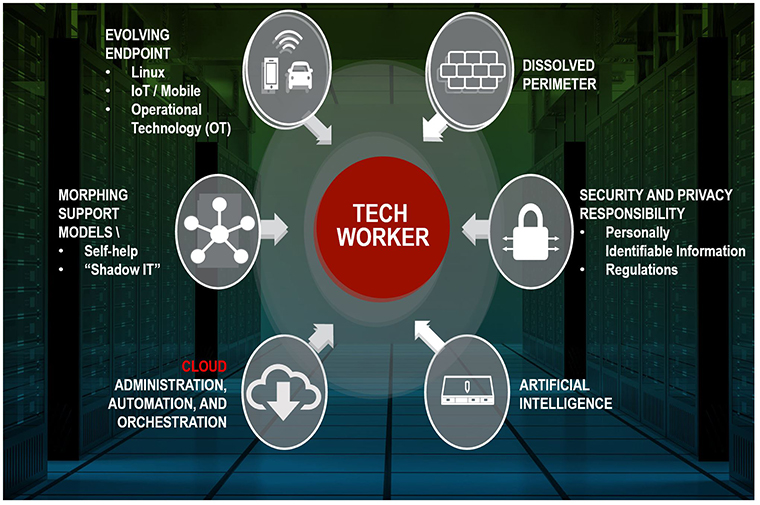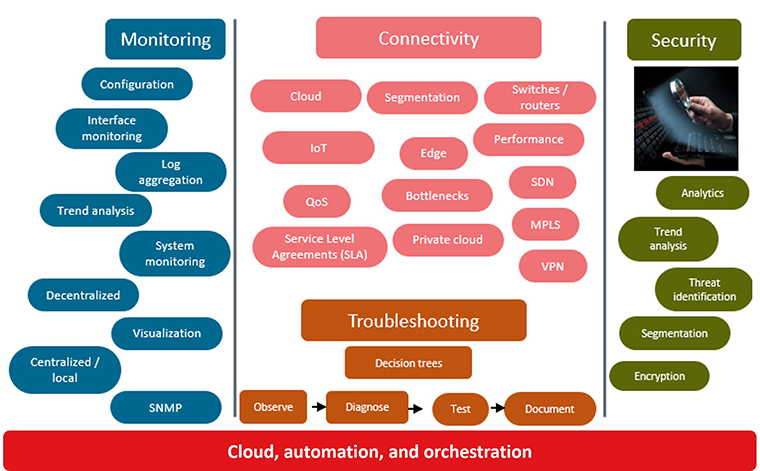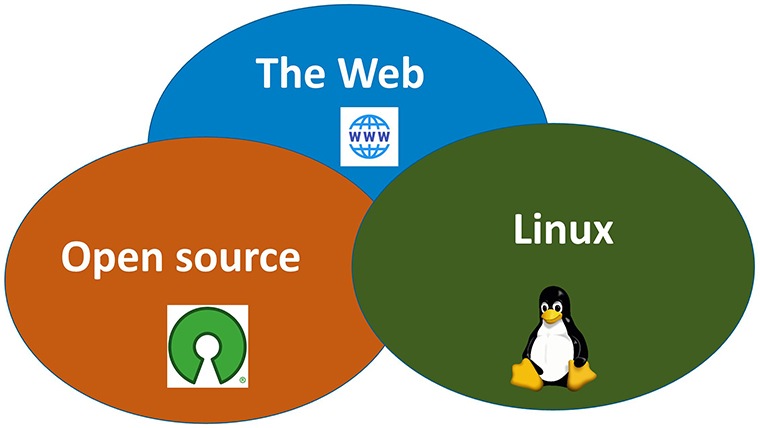Date Published October 9, 2019 - Last Updated December 17, 2019
We’re seeing massive changes in the IT environment. It is creating what I call a “great drift northward” in terms of skills that the tech worker needs. 
As a result, we’re seeing a major “shift left” in skills. Today’s tech worker needs to focus less on script-based, by the numbers support, and more on monitoring, connectivity, and security, as shown in the figure below.

Notice that I’ve put cloud, automation, and orchestration at the bottom, but as an all-encompassing foundation. Let me start with that. I can’t discuss all of these new tech developments and each new skill. So, I’m going to focus on the cloud, the evolving endpoint (including IoT), and AI.
The Cloud
Our research at CompTIA is showing that after 10 years of talk, we’re finally seeing the world go “cloud-native.” For example, the United States Department of Defense (DoD) has recently directed its workers to use cloud-based solutions whenever possible. Dell, in India, has used cloud services as part of its solutions for years. But, it is getting even more aggressive in its use of the cloud.
I met with Dell executives in Bangalore and Hyderabad. I also had the chance to teach cybersecurity to a couple of thousand students in some CompTIA mini bootcamps. Some of these folks worked for Accenture and FBS bank. Others worked for universities or were students at universities such as Lovely Professional University (LPU).
Moving Beyond the Script
While I was at Dell, the leaders of their tech support division, which includes more than 7,000 individuals, met with me. They really put me through my paces. They challenged me at every turn, especially when I discussed how tech support workers needed to learn cloud-based technologies. They asked me if it was really the case that help desk workers would be asked to support cloud-based systems. I said that from my experience and CompTIA’s research in 2018 and through 2019, this is absolutely the case.
Today’s tech support workers, I told Dell, are being asked to conduct tasks that would have been reserved for cloud engineers just a few years ago. One of the reasons for this shift is that many of the tasks have become automated. But the primary reason is that because there are too few workers. There are so many open job requisitions around the world, not just at Dell or in India. As a result, tasks that were once left to specialists are now being given to any IT professional.
Upskilling the Workforce
But Dell, like many other companies, is faced with a serious problem: They need to upskill their employees to handle the cloud, as well as more sophisticated endpoint knowledge, and cybersecurity. Tech support individuals are now being asked to “spin up” Linux and Windows workstations and even servers. They’re also being asked to troubleshoot and resolve connectivity issues between company workers and the cloud-based services that they need to access. As a result, tech support workers can’t just work from scripts anymore. They need to think on their feet and evaluate issues. Sure, knowledge databases will help. So will self-help systems. But increasingly, workers need to understand network connectivity troubleshooting.
Tech support workers can’t just work from scripts anymore. They need to think on their feet.

The leaders of Dell’s technical support division then let me know that they weren’t resisting anything I was saying. They told me that, actually, they had come to this same conclusion a couple of months before. But, they wanted to really challenge me and ask me what I really felt was the case. They were actually relieved that I said these things, because they were looking for someone who represented the industry at large to confirm their own research. Thank goodness I stuck to my message; I was getting pretty nervous during that meeting.
The Evolving Endpoint: From Gaming Devices to Operational Technology
The cloud isn’t the only thing shifting tech support jobs to the left. We’ve also seen the endpoint change massively. We live in the world of connected, diverse devices. Everything is getting an IP address. Increasingly, we’re finding that support organizations—in large and small companies alike—are being asked to support a wide variety of “boxes.”
IoT and Tech Support
Endpoints are now just about any physical device, from an IoT “smart watch” to a pipeline or a power line. I remember talking to a tech support worker at the HDI conference. He told me that in one single day, he was asked to fix the research department’s projection devices so that they could communicate with each other and then had to go and troubleshoot the connection between two solar panels that weren’t talking to their master controller properly. Now that’s “device diversity.”
Tech workers need to understand myriad operating systems now, including Linux, Chrome OS, Android (really just a fancy version of Linux), and Apple iOS (really just a fancy version of Unix). The endpoint isn’t just a phone or a PC, anymore.
Increasingly, tech support workers are being asked to support three things:
- IoT devices: The physical device, in case it stops communicating with large networks.
- The network traffic generated by IoT devices: Increasingly, tech support workers are being asked to provide connectivity information so that network engineers can make Quality of Service (QoS) changes and throttle bandwidth.
- The data derived from the IoT devices: Organizations process the data that comes from IoT devices and turns it into actionable information. Today’s help desk workers are now being asked to help make sure that this information remains secure. This is not only because there aren’t enough cybersecurity workers. Tech support workers are being asked to help ensure that employees keep their information private.
Artificial Intelligence and Tech Support
It’s been fascinating to see how AI has become a buzzword over the past two years. I find this so interesting, because various products have been using AI and Machine Learning (ML) for years, now. Amazon, Tesco, and many security software providers have been using these technologies for some time. It’s only been relatively recently that they realized that they can use these terms to market their products. I remember talking to a worker at Symantec, who told me that they’ve been using technology that any reasonable person would call AI for almost 20 years.
Even though AI has been around for many years in our software, we nevertheless have seen AI impact technical support recently. In Chicago, I was lucky to interview two people who implement AI for tech support workers. Maddy Martin of Smith.AI and CrushBank’s David Tan do more than just talk about theoretical AI. They actually help shape AI-based solutions to help leverage tech support workers.
As they discussed the AI solutions they put in place every day, I found it gratifying to see that in general, AI isn’t really replacing entire job roles. Instead, it is doing two things:
- It is causing existing tech support jobs to shift left in skill. In other words, we’re finding that today’s tech support workers simply need to learn fewer repetitive skills and need to learn more about cybersecurity, complex troubleshooting, and how to engage in more complex reasoning.
- It is allowing companies to better leverage existing workers. Most companies find that they aren’t using their existing workers as efficiently as they could. AI is increasingly allowing workers to avoid repetitive tasks and focus on more complex issues. Sure, AI may replace more jobs one day. But for now, we’re seeing how AI can help folks, rather than harm them and their jobs.
It was during my interview with Maddy and David that I realized I had just picked up on another thread in the narrative: For now, AI isn’t really replacing entire jobs. But, it is more quickly than ever before creating conditions where people need to no longer rely on script-based approaches to technical support. Tech support today isn’t scripted; you can’t just phone it in, baby. The world of tech support is live, dynamic, and exciting. If it isn’t, you’re in the wrong job and will likely get replaced.
Take your troubleshooting and problem solving skills to the next level with an HDI bootcamp!
Learn more!
How Do We Keep Track of All of This Change?
The easy, fatuous answer is to say “study a lot.” But that’s not a very useful recommendation. I think most IT support workers keep up on current events. But, I’ve found that having three things in mind can help people keep track of all of the emerging technology that is inundating the tech support scene. These include keeping up on innovations in the Web, open source, and Linux, as suggested in the figure below.

I firmly believe that tracking these three elements will help you keep current and prioritize your study. For example, consider IoT technologies: Almost all IoT devices use Linux. They are often controlled through simple Apache Server or ngnix servers. That’s the Web. We’ve all heard about blockchain and bitcoin. Well, the open source community innovated its use in encryption technologies, as well as for smart contracts. Want to talk cybersecurity? Well, most cybersecurity tools used by both red teamers (including pen testers) use Linux. Security analysts (also called “blue teams”) use Linux systems to listen for attackers and red teamers.
And when it comes to AI and ML, many of those innovations are spearheaded by open source communities using Linux systems. The Apache Foundation and Linux Foundation are central to advances in AI, ML, as well as blockchain and IoT.
So, I thought I’d share this emerging tech trifecta, or “hat trick” so that you, too, can keep track of emerging tech that we’re now supporting and will be supporting.
James Stanger is a respected authority in security, service desk, open source, ITSM, networking, and IT certification. Over the past 20 years, he has consulted with corporations, governments, and learning institutions worldwide, including IBM, Symantec, the US Department of State, the US Department of Defense, the Scottish Qualifications Authority (SQA), and the United Arab Emirates Cultural Division. He has published dozens of books and articles concerning IT, and developed education and certification programs used around the world. Follow James on Twitter @jamesstanger.